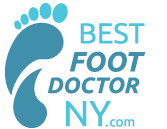Bunions can be painful, limit your mobility, and make wearing certain shoes uncomfortable. If you’ve been dealing with a bunion or tailor’s bunion and conservative treatments haven’t worked, it may be time to explore surgical options. Some bunions can worsen over time and lead to secondary foot issues if not addressed. Understanding your options is the first step toward lasting relief. This guide compares the most effective types of bunion surgery to help you understand which method might be right for your feet, based on your condition and lifestyle. For residents in Queens, NY, finding the right bunion surgeon can make all the difference in your outcome and recovery.
Keeping your feet healthy is important for preventing complications, especially if you have conditions like diabetes or reduced circulation. See our tips for keeping your feet healthy to better understand daily care habits that support your recovery and long-term foot health.
Book your consultation with Best Foot Doctor NY, a trusted bunion surgeon in Queens, today and take the first step toward comfort and mobility. Our expert team provides compassionate, medically advanced bunion care tailored to your unique needs, ensuring a path to pain-free walking and lasting foot health.
What Are the Main Types of Bunion Surgery?
To learn more about bunion surgery options in Queens and what to expect during recovery, visit our dedicated bunion surgery service page. This page provides detailed information on the procedures we offer, recovery timelines, and how our team at Best Foot Doctor NY can help guide you through every step of your treatment.
Traditional Osteotomy
Osteotomy is one of the most widely used bunion surgeries. The procedure involves cutting and realigning the bone to correct the deformity, allowing for more natural foot function post-recovery. It may also involve adjusting surrounding tendons and ligaments to improve stability and alignment. This method is typically used for moderate to severe bunions, especially when conservative treatments have failed to provide relief.
Pros:
- Long-established and well-understood technique
- Suitable for a wide range of bunion severities
Cons:
- Larger incisions
- Longer recovery (6 to 12 weeks of limited activity)
- Higher risk of recurrence if joint instability remains
Minimally Invasive Bunion Surgery
This approach uses small incisions and specialized tools to realign the bone with less disruption to surrounding tissues. The technique minimizes trauma, lowers the risk of infection, and supports quicker healing. Minimally invasive techniques are ideal for patients with mild to moderate bunions who want faster recovery, minimal scarring, and a more comfortable postoperative experience overall.
Pros:
- Smaller incisions and less visible scarring
- Less pain and swelling post-surgery
- Quicker return to regular activities
Cons:
- Not always suitable for severe deformities
- Requires a highly skilled bunion surgeon
Lapiplasty (3D Bunion Correction)
Lapiplasty is a modern procedure that addresses bunions at the root by correcting the misalignment in all three planes. This method is designed to restore the natural alignment of the foot and reduce the likelihood of the bunion returning. This technique uses titanium plates to stabilize the joint at the base of the first metatarsal, offering long-term correction and structural support for improved mobility and comfort.
Pros:
- Addresses the true structural cause of the bunion
- Low recurrence rates
- Can often bear weight in a walking boot shortly after surgery
Cons:
- More complex than other procedures
- Requires a surgeon trained in 3D bunion correction
Tailor’s Bunion Surgery
Tailor’s bunions occur on the outer side of the foot near the pinky toe. These bony bumps can cause localized pain, swelling, and difficulty fitting into narrow shoes. Surgical correction often involves shaving down the bony prominence, realigning the fifth metatarsal, and occasionally adjusting surrounding soft tissues for better structural support and reduced recurrence.
Pros:
- Targeted solution for lateral foot pain
- Can be minimally invasive
Cons:
- Different recovery protocol from big toe bunion surgery
- Still requires proper footwear and rehabilitation post-surgery
Which Bunion Surgery Is Right for You?
The best procedure depends on several factors:
- Severity and location of your bunion
- Bone stability and joint flexibility
- Lifestyle and activity level
- Whether this is a first-time or revision surgery
A top NYC podiatrist will evaluate your foot structure using advanced imaging and recommend a personalized treatment plan. Our diagnostic approach often includes digital foot X-rays to understand joint misalignment and tailor your treatment accordingly. At Best Foot Doctor NY, our bunion surgeons in Queens specialize in both traditional and modern procedures to ensure the most effective, lasting results.
Healing a Bunion with a Top NYC Foot Surgeon
Why See a Bunion Doctor in Queens, NYC?
Choosing a local specialist offers clear advantages. You gain access to in-person consultations, digital diagnostics, and timely post-operative care, which is essential for a smooth surgical experience. Local care also means easier follow-ups and better continuity of treatment. Our podiatrists are highly experienced in treating both bunions and tailor’s bunions using evidence-based surgical techniques. At Best Foot Doctor NY, we understand the unique needs of Queens residents and provide solutions that balance medical precision with patient convenience and comfort. Having a trusted bunion doctor nearby ensures you get the care you need, exactly when you need it.
Schedule a Consultation with a Bunion Surgeon in Queens
If bunion pain is disrupting your daily routine, don’t wait. The earlier you address the issue, the more options you’ll have for effective treatment. Whether you’re dealing with a mild bunion or a more advanced case that requires Lapiplasty, timely care leads to better results and quicker recovery. Schedule an appointment with a trusted bunion doctor in Queens today to receive an expert evaluation and a personalized treatment plan. Your path to comfortable, pain-free movement can start with one consultation.
